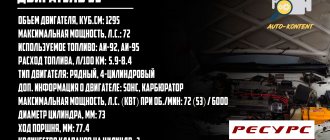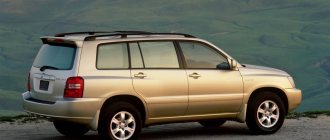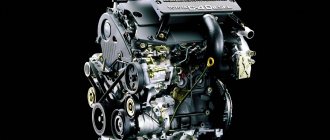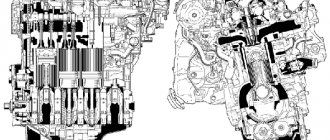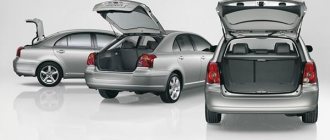The variety of powertrains in the popular Toyota Avensis raises many questions. What is the service life of the engine, is it possible to do major repairs, how to avoid premature wear. It's difficult to figure it out. Under the hood of the famous Japanese model you can find engines with a volume of 1.6 to 2.0 liters. There is a series of diesel engines. There are modifications specific to a certain year of manufacture.
Let's take a step-by-step look at the features of the Avensis configuration.
Variety of powerplants
On the Avensis of the first generations (1997 - 2003), the manufacturer installed power plants of the A, ZZ, S series, and diesel TD, D4-D. ZZ series engines are not subject to major overhaul, unlike A series power plants.
Diesel engines (TD, D4-D) are demanding on fuel quality. There is insufficient power of early diesel engines, which leads to sluggish overtaking and weak dynamic characteristics.
Cars produced from 2003 to 2009 were equipped with engines that inherited all the shortcomings of the ZZ series. Basically, the manufacturer has significantly expanded its line of diesel power units in these years. Under the hood of second-generation cars you can find diesel engines from 116 to 177 hp. (D-4D, D-4DF, D-4D D-CAD) There is a choice between dynamics and economical fuel consumption.
The third generation, since 2009, has been equipped with ZR power plants. The manufacturer managed to correct the main shortcomings of the failed ZZ. Gasoline engines, by tradition, have remained disposable. For many buyers in Russia, this fact causes the greatest irritation.
Powerful diesel units of the new D-CAT series are economical, but require maintenance and consumables.
Let's take a closer look at the features of each engine.
Engines 4A-FE (4A-GE, 4A-GZE) 1.6 l.
- Engine capacity, l - 1.6.
- Power, hp — From 90 to 170.
- The fuel used is gasoline.
- Consumption, l/100 km - 8 - 13.
- Number of valves - 4.
The 4A engine is one of the most successful for its time. At the very beginning, it was a carburetor economical engine, for which the Avensis body was too heavy. Subsequently, the manufacturer supplied a head with 16, and after a short period of time - with 20 valves, an improved piston, forced fuel injection.
Modifications:
- 4A-C - carburetor engine with eight valves, 90 hp. Installed on cars for the North American market from 1983 to 1986. Compression ratio 9.3.
- 4A-L - a similar engine for European countries, with a power of 84 hp.
- 4A-LC - especially for Australian buyers, with reduced power to 78 hp. Produced until 1988.
- 4A – E – engine with injector. Power up to 78 hp Produced until 1988.
- 4A-ELU - differs from the previous modification by the installed catalyst and increased power, up to 100 hp.
- 4A-F - carburetor engine with 16 valve head. Power 95 hp A similar version was produced with a reduced displacement to 1.5 l - 5A. Years of production: 1987 - 1990.
4A-FE - differs from the previous version by forced fuel injection:
- 4A-FE Gen 1 – electronic control of gasoline supply, engine power 102 hp;
- 4A-FE Gen 2 – engine with improved camshafts, finned valve cover. Power up to 110 hp;
- 4A-FE Gen 3 is the latest mod in this series. Improved intake manifold. Power increased to 115 hp. The engine was produced until 2001. This power plant was equipped with cars for Japan.
4A-GE – engine with MPFI injection:
- 4A-GE Gen 1 “Big Port” - the unit was produced from 1983 to 1987. It was equipped with a T-VIS intake manifold. Power was up to 124 hp. For countries with strict environmental requirements, the power was specially reduced to 112 hp;
- 2 4A-GE Gen 2 - second version, compression ratio increased to 10, power increased to 125 hp. Production began in 1987 and ended in 1989;
- 4A-GE Gen 3 “Red Top”/”Small port” - modification with a smaller intake manifold and an increased compression ratio to 10.3. Power was 128 hp. Years of production: 1989-1992;
- 4A-GE Gen 4 20V “Silver Top” - fourth generation. For the first time, 20 valves were installed, a VVTi variable timing system was installed, the intake manifold was changed, and the compression ratio was increased to 10.5. The changes made it possible to increase power to 160 hp. This modification was produced from 1991 to 1995;
- 4A-GE Gen 5 20V “Black Top” is the latest mod for this engine. The throttle valve has been improved, the pistons have been lighter, and the flywheel has been modified. The compression ratio reached 11, the power was increased to 165 hp. at 7800 rpm. The power unit was produced from 1995 to 1998.
4A-GZE - differs from 4A-GE 16V in the installed compressor. Options:
- 1 4A-GZE Gen 1 - compressor 4A-GE with a pressure of 0.6 bar, supercharger SC12. Forged pistons were installed. The intake manifold was made with variable geometry. Compression – 8. Output power 140 hp. This option was produced from 86 to 90;
- 2 4A-GZE Gen 2 - compressor pressure increased from 0.6 to 0.7 bar. Improved intake. The compression ratio is increased to 8.9. The changes led to an increase in power to 170 hp. Engines were produced from 1990 to 1995.
Engines of early modifications are rare. Despite their maintainability, they have exhausted their service life. Units of later releases are distinguished by excellent reliability. Increased fuel consumption and other malfunctions are most likely associated with failure of pressure and temperature sensors and contamination of the throttle valve. We should not forget about changing fuel filters, especially when using low-quality gasoline or the car has been sitting for a long time with an empty tank.
The disadvantage of this series of power plants can be considered high oil consumption, up to 1 liter per 1000 km. With increased consumption, replace the rings and valve stem seals.
The resource of the 4A installation usually does not decrease below 300,000 km. mileage
For tuning you need to choose 4A engines - GE modifications. To increase power to 250 hp. a direct-flow exhaust, a powerful compressor are installed, the shafts are changed to obtain a phase of 320, the intake and exhaust channels are bored, the piston must be replaced to achieve a compression of up to 11 units and some other modifications. Maximum tuning allows you to get 400 hp or more.
Toyota Avensis engines. Official fuel consumption per 100 km.
Generation 1 (1997-2000)
Gasoline:
- 1.6, 101 l. sec., manual, front, 12.1 sec to 100 km/h, 9.4/5.9 l per 100 km
- 1.6, 110 l. p., manual, front, 11.7 sec to 100 km/h, 10.8/6.1 l per 100 km
- 1.8, 110 l. p., manual, front, 11 sec to 100 km/h, 9.6/6.2 l per 100 km/h
- 2.0, 128 l. p., manual, front, 9.3 sec to 100 km/h, 11.2/6.5 l per 100 km
Diesel:
- 2.0, 90 l. p., manual, front, 12 sec to 100 km/h, 8.5/5.4 l per 100 km
- 2.0, 110 l. p.s., manual, front, 11.4 sec to 100 km/h, 8/4.8 l per 100 km
Restyling generation 1 (2000-2003)
Gasoline:
- 1.6, 110 l. p., manual, front, 11.7 sec to 100 km/h, 10.6/6.1 l per 100 km
- 1.8, 129 l. p.s., automatic, front, 10 sec to 100 km/h, 9.9/6 l per 100 km
- 1.8, 129 l. p., manual, front, 10 sec to 100 km/h, 9.9/6 l per 100 km
- 2.0, 128 l. p., manual, front, 9.3 sec to 100 km/h, 11.3/6.6 l per 100 km
- 2.0, 128 l. p.s., automatic, front, 10.6 sec to 100 km/h, 12.4/7 l per 100 km
- 2.0, 150 l. p.s., automatic, front, 9.1 sec to 100 km/h, 10.6/6.7 l per 100 km
- 2.0, 150 l. p., manual, front, 9.1 sec to 100 km/h, 10.6/6.7 l per 100 km
Diesel:
- 2.0, 90 l. p., manual, front, 12 sec to 100 km/h, 8.5/5.4 l per 100 km
- 2.0, 110 l. p.s., manual, front, 11.4 sec to 100 km/h, 8/4.8 l per 100 km
Generation 2 (2003-2006)
Gasoline:
- 1.6, 110 l. p., manual, front, 12 sec to 100 km/h, 9.5/5.8 l per 100 km
- 1.8, 129 l. p., manual, front, 10.3 sec to 100 km/h, 9.4/5.8 l per 100 km
- 1.8, 129 l. p.s., automatic, front, 11.6 sec to 100 km/h, 10.3/6.3 l per 100 km
- 2.0, 147 l. p., manual, front, 9.4 sec to 100 km/h, 10.6/6.6 l per 100 km
- 2.0, 147 l. p.s., automatic, front, 11.1 sec to 100 km/h, 12.8/7.2 l per 100 km
- 2.4, 163 l. p.s., automatic, front, 9.3 sec to 100 km/h, 13.5/7.2 l per 100 km
Diesel:
- 2.0, 116 l. p., manual, front, 11.2 sec to 100 km/h, 7.5/4.9 l per 100 km
- 2.2, 148 l. p.s., manual, front, 9.3 sec to 100 km/h, 6.3/4.1 l per 100 km
- 2.2, 150 l. p., manual, front, 9.3 sec to 100 km/h, 7.6/4.9 l per 100 km
- 2.2, 175 l. p., manual, front, 8.6 sec to 100 km/h, 6.4/4.3 l per 100 km
Restyling generation 2 (2006-2008)
Gasoline:
- 1.8, 129 l. p., manual, front, 10.3 sec to 100 km/h, 9.4/5.8 l per 100 km
- 1.8, 129 l. p.s., automatic, front, 10.3 sec to 100 km/h, 9.4/5.8 l per 100 km
- 2.0, 147 l. p., manual, front, 9.4 sec to 100 km/h, 10.6/6.6 l per 100 km
- 2.0, 147 l. p.s., automatic, front, 11.1 sec to 100 km/h, 12.8/7.2 l per 100 km
- 1.8, 129 l. p., manual, front, 10.3 sec to 100 km/h, 9.4/5.8 l per 100 km
- 2.4, 163 l. p.s., automatic, front, 9.1 sec to 100 km/h, 13.5/7.2 l per 100 km
Generation 3 (2009-2011)
Gasoline:
- 1.6, 132 l. p., manual, front, 10.4 sec to 100 km/h, 8.3/5.4 l per 100 km
- 1.8, 147 l. p., variator, front, 10.4 sec to 100 km/h, 8.6/5.6 l per 100 km
- 1.8, 147 l. p., manual, front, 9.4 sec to 100 km/h, 8.5/5.4 l per 100 km
- 2.0, 152 l. p., variator, front, 10 sec to 100 km/h, 9.2/5.7 l per 100 km
Restyling generation 3 (2011-2015)
Gasoline:
- 1.8, 147 l. p., variator/mechanics, front, 8.6/5.6 l per 100 km, 10.4 sec to 100 km/h
Second restyling of generation 3 (2015-present)
Gasoline:
- 1.6, 132 l. p.s., manual, front, 10.4 sec to 100 km/h, 8/5.1 l per 100 km
- 1.8, 147 l. p., manual, front, 9.4 sec to 100 km/h, 8.1/4.9 l per 100 km
- 1.8, 147 l. p., variator, front, 10.4 sec to 100 km/h, 8.4/4.8 l per 100 km
- 2.0, 152 l. p., variator, front, 10 sec to 100 km/h, 8.3/4.9 l per 100 km
Diesel:
- 1.6, 112 l. p., manual, front, 11.4 sec to 100 km/h, 5.1/3.6 l per 100 km
- 2.0, 143 l. p., manual, front, 9.5 sec to 100 km/h, 5.7/3.8 l per 100 km
Power unit 7A-FE 1.8 l.
- Engine capacity, l. - 1.8.
- Power, hp - 120.
- Fuel used, gasoline - 92.
- Consumption, l/100 km, highway – mixed. — city — 4.23 — 5.3 — 7.2.
- Number of cylinders - 4.
- Power system - Injector.
The Toyota 7A unit differs from the base 4A by increasing the piston stroke to 85.5 mm. Depending on which countries the car was exported to, the power was set from 105 to 120 hp.
If you have a choice, it is better not to take the reduced power version of Lean Burn.
The engine is reliable when used correctly. Particular attention should be paid to valve adjustment.
In 1998, they began to produce a replacement - the 1ZZ engine, its characteristics and features are presented below.
Engine Toyota 3S-FE/FSE/GE/GTE 2.0 l.
- Engine capacity, l. - 2.0.
- Power, hp - Up to 260.
- Fuel used, gasoline - 95, 98.
- Consumption, l/100 km, highway – mixed. — city — 8 – 9.5 – 13.
- Number of cylinders - 4.
Toyota 3S is the most popular engine in the S series. It was produced from 1984 to 2007 inclusive. Timing belt drive. Modifications:
- 3S-FE is the base engine of the 3S series. Injector fuel injection. It runs on 92 gasoline, but 95 is better. Compression ratio is 9.8. There are two ignition coils. Power from 115 hp up to 130 hp depending on environmental requirements. The motor was produced from 1986 to 2000.
- 3S-FSE (D4) - the first engine with direct fuel injection. Power 150 hp Gas distribution of the VVTi system. Electronic throttle drive, EGR valve is provided for afterburning of remaining fuel in the exhaust gases. Compression ratio 9.8. power 150 hp 3S-GE is an improved version of 3S-FE. The cylinder head mechanism has been improved (with the participation of engineers from Yamaha). Execution options:
- 3S-GE Gen 1 - the mod was produced until 1989. Power from 135 hp up to 160 hp More powerful engines were equipped with an intake manifold with an adjustable window and T-VIS systems;
- 3S-GE Gen 2 - the second version of the GE motor, produced until 1993. The T-VIS system manifold has given way to ACIS. The compression ratio was increased from 9 to 10, power - to 165 hp;
- 3S-GE Gen 3 - the third mod, produced until 1999. The manufacturer changed the distribution mechanism, increased the compression ratio to 10.3 and power to 180 hp;
- 3S-GE Gen 4 BEAMS/Red Top is the fourth generation powerplant. Production began in 1997. Valve timing with VVTi adjustment, compression ratio increased to 11.1. The windows of the intake and exhaust channels were enlarged. All this made it possible to produce a mechanism with a power of 190 hp;
- 3S-GE Gen 5 is the latest change from GE. Variable phases on both distribution shafts - Dual VVT-i. Power 200 hp
3S-GTE. In parallel with the GE series, they were modified with a turbocharger - GTE:
- 3S-GTE Gen 1 - the first version, produced until 1989. A CT26 turbine was installed. Engine power 185 hp;
- 3S-GTE Gen 2 - the second modification. The turbine received a double casing and increased supercharging. Power plant power up to 220 hp. The mod was produced until '93;
- 3S-GTE Gen 3 - third version. A CT20b turbine was installed. Power was increased to 245 hp. The engine was produced until 1999;
- 3S-GTE Gen 4 is the latest version of the 3S series. The exhaust system has been improved. Power increased to 260 hp.
The series ceased production in 2007.
It is worth noting that despite its overall technology, the first engine with direct injection earned a reputation as a capricious unit. The 3S-FSE engine was installed from 1997 to 2003, when it was superseded by the new 1AZ-FSE.
In general, the power units of the modifications under consideration have a decent service life. With skillful use, you can drive 400,000 km. and more.
Tuning allows you to increase power up to 700 hp.
First generation
Toyota Avensis 2002
The first generation of the new model T210/220 rolled off the factory assembly line from 1997 to 2003. The concern presented a car under the brand name Avensis. Compared to the predecessors of the Carina E brand, the common parts of the vehicles remained the body and the engine. The new product was produced at the Burnaston plant. At the same time, the five-door Toyota Corolla passenger car began to be produced here. Even from the start, Avensis was given a choice of 3 gasoline engines with a volume of 1.6, 1.8 and 2.0 liters or a 2.0 liter turbodiesel. Toyota Avensis engines were in no way inferior to other cars in their class. There were three types of bodies: sedan, hatchback and station wagon, which was essentially a version for the Japanese market of the 2nd generation Toyota Caldina.
The entire line was distinguished by excellent assembly, impeccable reliability, a comfortable and spacious interior, a smooth ride, and numerous additional equipment. The model underwent a certain restyling at the very beginning of the third millennium. Valve timing adjustment systems were installed on the engines.
Satellite navigation has become a standard option in all car brands. The line was complemented by the Avensis SR sports car, equipped with a two-liter engine, sports suspension, and a tuning package. However, sales of first-generation passenger cars left much to be desired.
The list of motors, their volume and power is as follows:
- 4A-FE (1.6 liters, 109 horsepower);
- 7A-FE (1.8 liters, 109 horsepower);
- 3S-FE (2.0 liters, 126 horsepower);
- 3ZZ-FE VVT-i (1.6 liters, 109 horsepower);
- 1ZZ-FE VVT-i (1.8 liters, 127 horsepower);
- 1CD-FTV D-4D (2.0 liters, 109 horsepower);
- 1AZ-FSE D4 VVT-i (2.0 liters, 148 horsepower);
- TD 2C-TE (2.0 liters, 89 horsepower).
The length of the car was 4600 mm, width - 1710, height - 1500 mm. All this with a wheelbase of 2630 mm.
The large MPV-class Avensis Verso, which appeared on the market in 2001, could accommodate seven passengers. It was equipped with an exclusive 2.0 liter engine option. Its platform anticipated the second generation cars. In Australia, this model was simply called Avensis, and it was awarded the status of the best passenger car among those intended for transporting passengers. No other options were available here.
Features of ZZ series engines
In the ZZ series of power plants, the manufacturer switched to the production of disposable units. There may have been a positive economic impact. However, consumers noted a sharp decrease in the attractiveness of this series compared to the successful line of engines with class A:
- Impossibility of major repairs of the installation;
- High oil consumption;
- Low service life, often 200,000 km for engines manufactured before 2005;
- Floating speed even with excellent quality fuel;
- Increased vibrations and knocking.
The ZZ series is not suitable for tuning.
The cylinder block was made of aluminum. This led to the fact that at the slightest overheating the geometry changed and it was necessary to change the entire cylinder block.
After 2005, the service life of power units of this series increased to 400,000 km. But subject to very careful use.
Unit 3ZZ-FE
- Engine capacity, l. - 1.6.
- Power, hp - 109.
- Fuel used, gasoline - 95.
- Consumption, l/100 km, highway – mixed. — city — 5.9 — 7.0 — 9.0.
- Number of cylinders - 4.
- Power system - Injector.
3ZZ-FE was developed to replace the popular 4A. The engine turned out to be unsuccessful. No modifications were created based on it. The power plant has been produced since 2000. After 7 years, it was replaced by disposable 1ZR engines.
The power unit is not exempt from the shortcomings characteristic of the entire series. It is worth noting that in 2005 it was possible to solve the problem of oil consumption and increase the service life to 400,000 km. As a plus, we can note the high reliability of the power unit with careful operation within the entire resource. Replacing the timing belt with a timing chain drive allowed the manufacturer to double the service life of the power plant before scheduled maintenance, compared to the 4A engine.
Engine Toyota 1ZZ
- Engine capacity, l. - 1.8.
- Power, hp - 109.
- Fuel used, gasoline - 92.
- Consumption, l/100 km, highway – mixed. — city — 5.9 — 7.0 — 9.0.
- Number of cylinders - 4.
- Power system - Injector.
The 1ZZ motor became the first and most widespread of the entire series. Execution options:
- 1ZZ-FE - main mod, manufactured at Toyota Motor Manufacturing West Virginia. Power up to 140 hp The modification was produced from 1998 to 2007;
- 1ZZ-FED - a copy of 1ZZ-FE, produced at Shimoyama Plant. Lighter forged connecting rods were installed on the engine. Unit power 140 hp;
- 1ZZ-FBE - 1ZZ-FE engine specifically for Brazil. The mod allows you to use biofuel.
The high oil consumption characteristic of the entire series can be reduced. To do this, you need to replace the rings with new ones manufactured later than 2005. The engine has decent low-end torque, which is a plus for travelers on wide, spacious roads.
Engine Toyota 1AZ
- Engine capacity, l. - 2.0.
- Power, hp - 150.
- Fuel used, gasoline - 95.
- Consumption, l/100 km, highway – mixed. — city — 7.3 – 9.8 – 11.4.
- Number of cylinders - 4.
- Power system - Injector.
The AZ engine series has been produced from 2000 to the present. Aluminum cylinder block. The basic powerplant 1AZ-FE/FSE is designed to replace the 3S-FE/FSE. There are few modifications so far:
- 1AZ-FE - Main engine, depending on permissible environmental standards, power 145 and 150 hp;
- 1AZ-FSE (D4) - direct injection engine. Compression ratio increased to 11. Power up to 155 hp.
The engine cannot be overhauled. The resource is above average. With normal care, exceeds 300,000 km. mileage All versions on which the FSE (D4) system is installed require high-quality fuel.
Common tuning involves installing a ready-made supercharging kit and minor modifications to the unit itself. The power of the power plant increases to 200 hp.
Engine Toyota 2AZ
- Engine capacity, l. - 2.4.
- Power, hp - 170.
- Fuel used, gasoline - 95.
- Consumption, l/100 km, highway – mixed. — city — 8.6 – 10.8 – 13.
- Number of cylinders - 4.
- Power system - Injector.
The 2AZ power unit is based on the base model of the series. The cylinders are bored to 88.5 mm in diameter and the piston stroke is increased by 10 mm. The balancer systems have been improved to ensure smooth running.
Modifications:
- 2AZ-FE - 160 hp unit. Since 2008, power has been increased to 166 hp. due to minor design modifications;
- 2AZ-FSE - direct injection unit. Power 163 hp Produced from 2000 to 2009;
- 2AZ-FXE - installation for hybrid vehicles with the Atkinson cycle. Differs in compression ratio - 12.5. Installed power 130 and 150 hp.
These engines roll back more than 300,000 km. As with the entire series, they cannot be repaired.
For tuning there is a kit kit that allows you to increase power to 300 hp. But the engine life is significantly reduced.
Toyota 1ZR engine
- Engine capacity, l. - 1.6.
- Power, hp - 134.
- Fuel used, gasoline - 95.
- Consumption, l/100 km, highway – mixed. — city — 5.8 – 6.9 – 8.9.
- Number of cylinders - 4.
- Power system - Injector.
Power units of the ZR series have been produced since 2007. Replaces unsuccessful engines of the ZZ line. The designers installed a variable phase system on the intake and exhaust shafts (Dual VVT-i). The provided Valvematic system allows you to adaptively change the valve lift. Hydraulic compensators eliminate the need to adjust valves.
The engine is disposable, the block is aluminum. The average resource is 250,000 km. And this is with good care and moderate stress.
There are two modifications, but they were not installed on Toyota Avensis.
In general, owner reviews are positive. The engine turned out to be reliable, as long as the fuel and oils are of high quality.
Toyota 2ZR engine
- Engine capacity, l. - 1.8.
- Power, hp - 147.
- Fuel used, gasoline - 95.
- Consumption, l/100 km, highway – mixed. — city — 5.3 – 6.4 – 8.3.
- Number of cylinders - 4.
- Power system - Injector.
The 2ZR unit has a longer piston stroke than the 1ZR. Other differences compensate for the increased crankshaft stroke.
There are two modifications installed on Avensis (three in total):
- 2ZR-FE is the main unit. Power 134 hp;
- 2ZR-FAE - block with Valvematic system. Power increased to 150 hp.
The engine rolls on average 250,000 km. With good care, the unit is problem-free.
A kit tuning kit allows you to increase power to 300 hp. In this case, the engine resource drops sharply.
Toyota 3ZR engine
- Engine capacity, l. - 2.0.
- Power, hp - 158.
- Fuel used, gasoline - 95.
- Consumption, l/100 km, highway – mixed. - city - 6.4 - 8 - 10.
- Number of cylinders - 4.
- Power system - Injector.
3ZR is the most powerful power unit of the series in question. Produced since 2007. There are three modifications, two are installed on Avensis:
- 3ZR-FE is a dual VVTi engine. Power 143 hp;
- 3ZR-FAE - with Valvematic. Power increased to 158 hp.
The motor in question does not have any new disadvantages or advantages compared to less powerful units of the ZR series. With normal care, the resource exceeds 250,000 km. The block cannot be repaired.
We looked at gasoline engines and their modifications. Let's now turn our attention to diesel power units.
Diesel engines
If the diesel is filled with high-quality fuel, then one can only rejoice. Economy, throttle response, quite decent mileage, reliability – these are the criteria noted by diesel owners.
But, as usual, there are nuances. Diesel engines are expensive to repair and maintain. Cars with such power units are not officially supplied to countries with low quality diesel engines. Dealers know how to service and repair diesel units, but it’s expensive.
However, there are enough diesel Avensis on the secondary market, and they are in good demand. There is often a craftsman who will tune up a diesel engine and carry out high-quality repairs at an affordable price.
Below we will consider diesel units in more detail.
Engine Toyota 2.0/2.2 D-4D and 2.2 D-CAT
Until 2008, the D-4D power unit developed 116 hp. Like the gasoline engines of the first generation cars, it was equipped with a timing belt type. The block was cast iron, the valve head was aluminum. According to the documents, the motor was designated by the code 1CD-FTV. The diesel engine has been produced since 1999.
- Engine capacity, l. — 2.0; 2.2.
- Power, hp — Up to 177.
- The fuel used is diesel.
- Consumption, l/100 km, highway – mixed. — city — 5.0 — 8.6.
- Number of cylinders - 4.
- Power system - Direct injection.
The engine was very successful. If the injectors were clogged, it was easy to restore them. Under normal operating conditions, the engines lasted 500,000 km. A major overhaul of the blocks was possible.
Since 2006, they began to produce the next family of diesel engines, with the same designation, D-4D. The block began to be made of aluminum. The timing drive has become a chain drive. The index of the unit became AD.
Versions:
- 1AD – engine with a cylinder capacity of 2.0 liters. Power 126 hp;
- 2AD is a unit with a piston stroke increased by 10 mm and modified balancers. Thus, the volume of the combustion chamber increased to 2.2 liters, power to 150 hp;
- 2 D-CAT – Denso piezo injectors with injection pressure up to 200 MPa are installed. A fifth nozzle is installed in the exhaust system to regenerate the particulate filter. The additional catalyst installed on this version made it possible to sell cars in countries with Euro 5 requirements. Power – 177 hp
The engine cannot be repaired. Units produced before 2009 are economical and reliable, but only with a mileage of up to 150 thousand km. Subsequently, the contact of aluminum and the gasket causes corrosion of the metal. Oxidation of the head after 150,000 km can only be eliminated by grinding the surfaces with the engine removed. This procedure can only be done once. Thus, the engine life rarely exceeds 300,000 km.
Since 2009, the oxidation problem has been resolved.
Second generation
Toyota Avensis 2005
Representatives of the second generation T250 were produced by the concern from 2003 to 2008.
The service life of the Toyota Avensis engine has increased significantly, and the general format of the line has also changed. Improvements affected the visual appeal of the car and driver assistance systems. The Avensis T250 brand was created in Toyota's design studio, located in France. She was left with 3 options for a gasoline engine with a volume of 1.6 liters, 1.8 liters, 2.0 liters and a turbodiesel with a two-liter volume. A 2.4L engine equipped with four cylinders was added to the line.
The T250 was the first Avensis to be exported to the Land of the Rising Sun. After the discontinuation of the Camry Wagon line, the Avensis Wagon passenger car (1.8l and 2.0l engine) began to be exported to New Zealand. In England, the T250 with a 1.6-liter engine was not available for sale.
The competition for European Car of the Year 2004 ended with the Toyota Avensis being knocked out of the top three. But in Ireland in the same year, the Japanese model was recognized as the best and was awarded the Semperit prize. Many considered it the best family car. In Switzerland, in 2005, they abandoned further production of the Toyota Camry. The Avensis passenger car has become the largest sedan of the Japanese corporation, intended for sale in Europe.
In England, for example, the car went on the market in the following trim levels: TR, T180, T Spirit, T4, X-TS, T3-S, T2. A special version called the Color Collection was based on the T2 configuration. In Ireland, the car was offered to customers in 5 trim levels: Sol, Aura, Luna, Terra, Strata.
From the very beginning, the Avensis was equipped with a D-4D diesel engine, equipped with a power of 115 horsepower. Then it was supplemented with a 2.2 liter D-4D engine and the following power indicators:
- 177 horsepower (2AD-FHV);
- 136 horsepower (2AD-FTV).
New versions of the engine marked the abandonment of the previous emblems on the trunk lid and front fenders. In Japan, the car is sold under the designations 2.4 Qi, Li 2.0, 2.0 Xi. Only the base 2.0 Xi model comes with four-wheel drive.
Second generation Avensis station wagon
The Avensis is the first car in the Land of the Rising Sun to receive all possible prestigious stars in the crash test rating. It was held in 2003 by the famous organization Euro NCAP. The car received a total of thirty-four points - this was the maximum possible result. In Europe, she became the first owner of knee airbags. The engine on the Avensis was rated highly.
The improved Toyota Avensis brand appeared on the market in mid-2006. The changes affected the front bumper, radiator grilles, turn signals, and an audio system that plays MP3, ASL, and WMA tunes. The materials for the seats and interior have been improved. A computer display with many functions and compatible with the navigation system was inserted into the optitron instrument panel. The front seats can now be adjusted in height.
Specifications have also been updated. Manufacturers installed a new D-4D engine with a power of 124 hp, complete with a six-speed manual transmission. Thus, harmful emissions and fuel consumption were reduced.
The second generation was equipped with the following engines:
- 1AD-FTV D-4D (2.0 l, 125 hp);
- 2AD-FTV D-4D (2.2 l, 148 hp);
- 2AD-FHV D-4D (2.2 l, 177 hp);
- 3ZZ-FE VVT-i (1.6 l, 109 hp);
- 1ZZ-FE VVT-i (1.8 l, 127 hp);
- 1AZ-FSE VVT-i (2.0 l, 148 hp);
- 2AZ-FSE VVT-i (2.4 l, 161 hp).
The length of the car is 4715 mm, width – 1760, height – 1525 mm. The wheelbase was 2700 millimeters.
Reviews from Toyota Avensis owners
At the very end, we suggest you read the reviews of car owners:
Problem with fuel D-4D
Hi all! On occasion, I bought a Toyota Avensis with the D-4D engine (1CD-FTV) in December. Mileage – 205,000 km. The car sat for a long time and was not driven by the previous owner. I changed the timing belt first, filters, oils, and other belts. I drove 10,000 and was happy.
But then the problems began. It won't start when hot. I installed it on the fuel system on the advice of XADO. It became tolerable, but not as much as before.
A new focus has emerged. At speeds of 120 and 3,000 rpm, the speed drops sharply to idle. The “toyota service” light comes on. After stopping and restarting the engine, the problem disappears and recurs when the specified speed is reached. Driving has become dangerous. When overtaking, a similar situation could arise. And the dynamics dropped sharply. I went for diagnostics. There was a queue at the service, so I just talked to the foreman. The repairman offered to buy from them and change the injectors. 300 bucks each. Said it would 100% help.
I decided to go to the folk craftsmen's garages. They used a scanner to determine the error code, 78(7). But they were never able to find a decryption of the code. But I got a printout of the engine scan result.
I sent the printout to Germany, fortunately I have friends there. The Germans said that there were problems with the fuel injection pump. I decided to carry out all sorts of cleanings. The engine ran for half an hour on Vynns out of a can. Replaced the fuel filters again. As a result, the dynamics were restored. But at any moment when starting off, the engine can stall. When hot it starts very hard again.
I went to the service center again. We replaced two injectors. The problems have disappeared. They said that poor quality fuel causes such problems. So now I choose gas stations with a good reputation.
Avensis 2001
My father switched to a Prado, and gave me a 2001 Avensis with a d4d diesel engine. The car came to us with a mileage of 150,000 km, but my dad had driven 85,000. We didn’t notice any problems. The engine works great. We ride in Bishkek. In winter at -30 °C it starts without problems. Only we change fuel filters twice as often as required. And we pour in diesel fuel that has been standing in a barrel.
Avensis 2.2 D4D – disappointment
Up to 120,000 km. there were no problems with the mileage. Then – grinding the head. The first time it came out crooked, I had to sand it further. The engine drove like this for another 100,000 km. Then they changed the gasket, chain, and pumps. There was a problem with the temperature rising. Antifreeze boils instantly. The radiator leaked, then the expansion tank. I replaced everything. My wife kept track of all expenses. We came to the conclusion that a gasoline engine with fuel and maintenance costs is cheaper than a diesel engine.
Review of Toyota Avensis 1.6 VVT-i (2009)
On December 24, 2009, after a 4-month painful search, I finally became the owner of a beautiful Toyota Avensis 2009. (new model). I will maintain the traditions of the forum and say a few words about what cars I compared my future purchase with, and what cars I drove before...
So! The loan documents have been submitted to the bank, a list of potential “victims” has been formed... yes... List of applicants as of 08/01/2009. consisted of a huge number of vehicles costing up to $20,000, I will only indicate the new cars that I considered:
- Mitsubishi LancerX intense,
- Outlander Classic 2.0i;
- Volkswagen Passat 1.4TSi (on offer);
- Volkswagen Jetta 1.6i;
- Skoda Octavia 1.6i (on offer);
- Toyota Corolla 1.6 comfort+;
- Suzuki SX4;
- yes, I almost forgot Peugeot 307;
- and the main contender))) ... - Great Wall Hover 2.8 tdi (on sale).
I would like to immediately explain the discrepancies in classes and in engines - Our “deeply respected Government” from 01/01/2010 decided to create a Customs Union with the Russian Federation and Uzbekistan (it seems) and due to the increase in import customs duty rates to the level of Russia, the question arose head on - either to new year, a new car, or drive who knows how long on scrap metal. In case anyone hasn't noticed, Avensis was not on the list above. It was a bit expensive at that time.
So, the wonderful Japanese brand Mitsubishi was chosen with its new LancerX - it was chosen, only the bank refused the loan at the last moment (without motivating its refusal) ... in mid-November. Time passed while the documents were being reviewed by the second bank... According to the marketing manager of the Mitsubishi car dealership, the warehouse is empty and no deliveries of Lancers (in the desired configuration) are expected until the new year, but in Finland there is the last Outlander Classic 2.0 as standard. 4 days have passed - hurray, the bank gives the go-ahead, but the dealer suddenly informs that the machine, bye bye... was sold to a more efficient client - profanity -.
It's December 14th!!! I’m sitting at home, out of grief, surfing the Internet and... lo and behold, a week later 3 Toyota Avensis cars arrive in standard 1.6 silver metallic at a discount and within the desired amount, namely $19,500. A mad trot to the bank on the same day, an agreement and an advance payment of 20% in cash... that's it!!! She is mine. Acceptance was scheduled for 12:00 on December 24, 2009... I received my Avenue, of course, not at 12:00, but 7 hours later (long live our snickering dealer).
And so I got behind the wheel for the first time. The delight was somewhat faded after so much time of waiting and hassle, but it was still there! Comfortable chairs... no, first about the exterior. The look of the car is not for everyone, it cannot be said that the car is not beautiful, it still has some zest, but the masculinity that I liked so much in the previous model has disappeared. The 2009 model is a kind of unisex, so to speak, a complete bisexual. IMHO. Since it was almost 350 km from the car dealership to home, and the temperature and road surface reminded us that the New Year was coming, the first thing I did was buy winter, studless Dunlop graspic DS3 tires
At the age of 30, I drove a huge number of cars and was the owner of the following “works” of the auto industry (in chronological order from the moment I received my license):
- 1998-2001 - VAZ 21061 1988. died (auto) from a blow to the ass of Ikarus));
- 2001-2003 — Nissan Primera 1992 2.0d;
- 2003-2005 - Renault Clio 1.2i 1994 (times were difficult);
- 2005-2009 — BMW 525tds station wagon automatic leather, etc. 1994;
- from 2009 to present – father’s VW POLO.
Interior: the first thing you feel in the Avensis 2009 is nothing, the car is like a car, no more, no less. All the parts fit perfectly, the gaps are even, you wouldn’t expect anything else from Toyota. The front seats are soft, comfortable, without pronounced lateral support both in the pelvis and back. Here it is worth making a reservation and explaining who is driving (that is, Me) - 190 cm tall, 125 kg weight - still a goon :))). The space in the car is enough for the eyes - sitting comfortably behind the wheel, I don’t touch (in winter clothes) either the driver’s door or the front passenger’s shoulder and calmly sit behind me on the back sofa - I almost don’t touch my knees.
The steering wheel has an optimal cross-section and thickness in girth (it’s a pity that there is no leather). I was pleased with the quality of the plastic in the cabin - pleasant to the touch, moderately soft! But the texture of the plastic caused conflicting feelings - on the one hand, a beautiful pattern with dashes (there were no other words), but on the other hand, it raises doubts about the difficulty of washing such a pattern.
The dashboard is a separate matter - Optitron is a thing)) It is perfectly visible in any lighting, although it fades when exposed to direct sunlight. The instrument cluster and its lighting are not annoying; the readings are perfectly readable in any situation. The computer is completely Russified, electronic!! Fuel level and coolant temperature sensors can be read without problems.
Mirrors!!! - no, these are not mirrors - PAWS - more acceptable on some crossover, they give an excellent view back, when configured correctly. The same cannot be said about the interior rearview mirror - the trunk is not visible at all, it is impossible to estimate the distance to an obstacle from behind (when moving backwards); the side mirrors help save the situation a little.
All switches, buttons, etc. in their places, I didn’t expect anything else... except for the power window buttons on the driver’s door, due to the original shape of the door handle, access to the buttons requires getting used to.
Seat upholstery?!?!?!?! - I still can’t understand how... how such a rag can be in this class of cars.
Armrest! — almost a trunk))) It fits a couple of liter bottles without problems — I really liked the spaciousness and didn’t like the location — moving it forward a little would be ideal, otherwise it’s not very comfortable for the hand to lie on.
The trunk is a sedan and in Africa a sedan - there is plenty of space. One minus is that the height of the trunk opening is very small - large cargo simply won’t fit in - I have difficulty pushing a baby stroller in without removing the wheels. Well, not the station wagon that I have become so accustomed to over the past 4 years))).
Driving on Avena also does not bring any serious surprises. The suspension is harsh, on small bumps and joints it shakes more than we would like, on the other hand, you take turns with minimal roll and you pass speed bumps without fear of leaving the suspension on the asphalt. Maybe in more expensive trim levels, stuffed with electronics and therefore heavier, the suspension will behave differently, but I have no complaints about the chassis, I’m completely satisfied.
The electric power steering isn't particularly sharp, but it's not needed for a family sedan. Yes, this is exactly how you should treat a car - a SOLID FAMILY SEDAN.
The gearbox has 6 steps - I would like to give +6 points for each forward gear and -10 for a reverse gear - clarity leaves much to be desired (perhaps a feature of only this instance).
It seemed that the pedal assembly was a little flimsy - a slight play in the clutch and brake pedals could also be a feature of this particular car and will disappear after adjustments.
Engine! 1.6 132 hp according to the passport and 129 hp according to customs documents!?!?!? What can I say... If I had more money and time, I would take 2.0 without thinking. The engine turned out to be very flexible, but you won’t expect any agility from it, it forgives mistakes when choosing gears and behaves smoothly, like a trolleybus, during acceleration - let’s say thanks to the new Valvematic system instead of the old VVT-i. I ask you not to evaluate this paragraph objectively, since the car is being run-in and I don’t allow it to exceed 3 thousand revolutions. I use AI95 gasoline. Although, according to storytellers, 92 can be easily digested. In this case, I am of the opinion that what is written in the instruction manual is what I do. What I didn’t like about the engine was the algorithm for warming up a cold engine - it keeps high speeds until FULLY warmed up, which does not contribute (in my opinion) to efficiency. At the moment, in winter, with all its warming up and short distances of movement (work - home), the computer shows the consumption according to the passport - 10.7 liters. per hundred in the city, although when driving from the dealership 350 km along the highway it showed an average of 6.8 liters. I hope that after 5-10 thousand km the consumption will return to normal.
As standard, the car is equipped with ABS, EBD, 6 airbags and... that's it!
Among the pleasant little things that turned out to be invaluable in our Russian winter, it is worth noting the heated seats and, most importantly, the heated glass in the area of the wiper blades))) - forget about frozen wipers.
I'm not a music lover, but the CD/MP3 player with 6 speakers in the base pleased me with good sound and even decent bass. Equipped with a system for automatically adjusting the volume depending on the speed of movement - a controversial thing, I don’t use it.
And now about what almost everyone likes to criticize in cars of Japanese manufacturers - sound insulation. I’ll just say one thing: at a speed of 130 km/h, my wife and I were talking in a low voice in the car, this was on winter tires and not on perfect asphalt. Yes, there is a problem in the area of both the front and rear arches, but this manifests itself when driving through puddles or sand.
That, in principle, is all I wanted to tell you about the 2009 Avensis. — a decent car in all respects (for its price). Maybe not everything is written fairly and there is a lot of confusion, but it’s better than nothing. I hope this review will help someone make the right choice.




